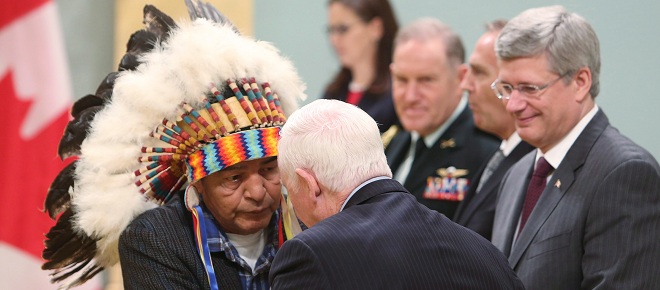Consensus absent when it comes to Aboriginal governance
How should Aboriginal government work in Canada? It’s not exactly an easy conversation.
CP/Fred Chartrand
Share

“This is a different from of government than what is traditional Canadian government. We have to understand it better. It’s not like we’ve had 100 years of accepting this. It’s only been in the last 30 years that this work has gone on in that direction, so Canadians have to catch up to it.”—NDP MP Dennis Bevington, who represents the Northwest Territories
Parliamentarians on the Aboriginal affairs committee have waded into a long-simmering debate about how Aboriginal government should work in Canada. It’s not exactly an easy conversation.
Whenever MPs talk about the way First Nations run their affairs, several sources of tension are bound to emerge. When the House aboriginal affairs committee first took a look at Bill C-27, the First Nations Financial Transparency Act, the usual controversial questions arose immediately.
Among the toughest is how to legislate transparency among Aboriginal bands across the country? Should the federal government make uniform demands of all bands? Or should the communities be free to create their own frameworks for governance? Where do the rest of Canadians fit into the conversation?
Every past bid to come to a conclusion on all of these issues has failed to arrive at anything approaching a consensus. Among the witnesses at the committee over the past two weeks were First Nations leaders who argued for autonomy from various angles.
“As far as the chief and council salaries, we actually have a chief and council compensation commission in our community that’s made up of our membership. They set our salaries. We don’t set our salaries,” said Darcy Bear, the Chief of the Whitecap Dakota First Nation.
“Legislatively, we are governed by a general assembly. Every adult member of the first nation is a member of the legislature,” said Chief Roland Twinn of the Sawridge First Nation.
Clarence Paupanekis, a councillor from the Norway House Cree Nation, said: “Our practice in Norway House Cree Nation is to hold a community meeting to share our audited financial statements and explain in simple terms what the financial statements read.”
Their points are aren’t exactly parallel. They refer variously to transparency, specifically, and governance more generally.
But what they have in common is a claim from each First Nation about how it reaches similar ends— transparency and good governance—using different means. On the other hand, a Hansard’s worth of conversation argues about those bands that are neither transparent nor governed effectively. Indeed, witnesses to the committee disagree even about basic statistics involving how much corruption and incompetence exists among aboriginal nations in Canada.
But one thing is certain: There are hundreds of bands in each province and territory, and they’re not strictly governed—nor do many wish to be governed—according to some financial management or governance framework created by the Government of Canada.
Not much is agree upon, but one thing is certain: hundreds of bands, scattered across each province and territory, are not strictly governed—under any federal financial management or governance framework. Many don’t want that oversight.
Below, to illustrate the sheer volume of aboriginal government in Canada, is a map of every aboriginal community.
Aboriginal communities across Canada
GREEN: Inuit; BLUE: First Nations; RED: Métis
What’s this map all about?
This map comprises every aboriginal community in Canada, and was compiled by the Aboriginal Canada Portal. It’s available for download, so you can grab it yourself and do what you please with the data.